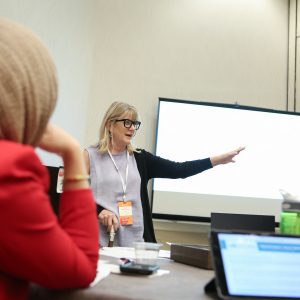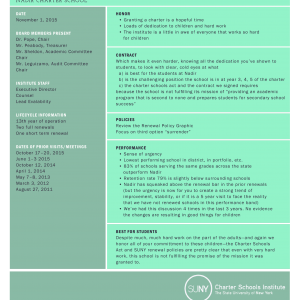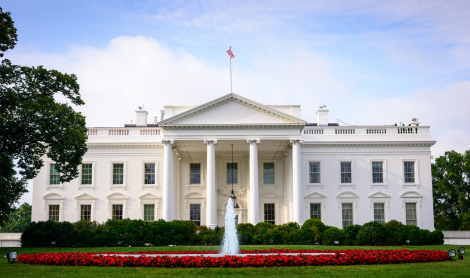This piece is part of our interactive, Authorizer Showcases, which highlight how authorizers around the country are tackling obstacles related to access and accountability.
Susie Miller Carello, Executive Director, SUNY Charter Schools Institute, authorizes 186 schools serving over 6,000 students. The State University of New York—a higher education authorizer—started authorizing schools in 1999.
Susie shares how authorizers can use clear communication to work with the board to voluntarily relinquish the charter (rather than initiate a formal closure)–a process that puts children and communities first. Her perspective on community-centered closure is based on 20 years doing this work, and her experience holding to their high standards: nine percent of SUNY’s charter schools have not been renewed.

How did they end up making that decision? It has everything to do with how we set up the relationship from the beginning, and the tools we use for a shared understanding of exactly where the school stands at every point in their life cycle.
Over the course of five years, if a school is failing, and has data in hand, and clarity about efforts made (or not made) to improve, that school usually arrives at the necessary conclusion: for the good of their students, the school must close.
We think a lot about leveraging the life cycle of the charter: how we both maintain the high quality of our schools but also use the opportunity to hold up what we consider to be a pretty harsh mirror—in the nicest way possible—to tell schools that they are not cutting it.
This visual of our renewal policies, like the one below, is an important tool that everyone in our office uses on a regular basis. It shows that if a school does not have a strong program on the ground and does not have demonstrated progress towards having met their accountability goals, it is not to be renewed. We review this with every school, multiple times.
SUNY’s Renewal Policies clearly outline three potential outcomes for schools facing renewal for the first time: Full-term renewal (5 years), Short-term renewal (3 years) or Non-renewal (closure).
Schools get a lot of information from us during their life cycle, and they become very familiar with the documents we use. This is a critical one: if there are more question marks or No’s than check marks or Yes’s, that means action.
Each year in the life cycle brings more information and action. By Year 3, if a school is on track for renewal, we continue to review reports and give the school academic accountability documents. If it’s not on track for renewal, we are in their shorts, like a swarm of ants, using those benchmarks to generate reports on the school’s performance. We meet with the board, and we produce a formal report. The school also gets a letter from us, with this key sentence: ‘Based on this record of academic performance, your school’s prospects for earning a renewal are currently in jeopardy.’
With two, three, or four years of documentation, it’s easy to talk to a board. Here’s what else we say: ‘The Charter Schools Act of New York gives you five years to show that you actually are making progress implementing the design you laid out for your school. You signed up for not just access to millions of dollars of public funds, but the responsibility for the lives of children. It’s Year 3. Year 5 will be here in the blink of an eye. What are you doing?’

In Year 4, if the school is not on track, we repeat all these actions. We convey a sense of urgency, and our schools understand the escalating nature of our communication. In Year 5, if you’re meeting our renewal policies, we have a short visit. If you’re not, we do long, multiple visits and we detail, in person and in writing, how a school is not meeting the guidelines for renewal. When we sit down with a school, we have a script for what we want to communicate, and this too is part of documenting our steps well. It’s important to practice how to deliver this tough message.
By working with the charter school all along their lifecycle, and using clear expectations and clear language, they see what we see. This encourages the board to voluntarily surrender the charter, making the right decision for the children, no matter how hard it is for the school.
When a charter school board decides to not pursue renewal, we are honest but respectful of that board. I use the word ‘honor’ with the board. The board chair has my cell number and uses it. We talk about how deciding to close is the most difficult and respected thing a school board can do. We help them know we will say only respectful things about them. We ensure them we’ll be their partner in helping to transition the students. I think this is a critical component. We are not in the business of shaming people. We are in the business of lifting up the adults so they do the right things for children.


